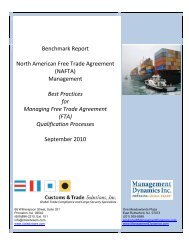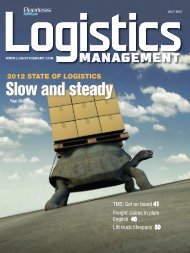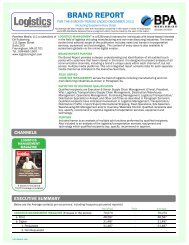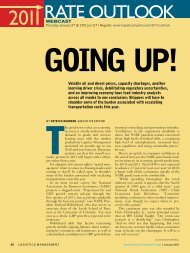Download - Logistics Management
Download - Logistics Management
Download - Logistics Management
You also want an ePaper? Increase the reach of your titles
YUMPU automatically turns print PDFs into web optimized ePapers that Google loves.
which Welch labeled “excellent<br />
companies.”<br />
Those three regional companies<br />
posted a combined operating ratio<br />
(OR) of 93.5. Except for industry<br />
profit leader Old Dominion Freight<br />
Line (85.1), that is the best OR<br />
posted by any publicly held regional<br />
LTL carrier during the less-thanrobust<br />
third quarter the ended<br />
September 30. For the first nine<br />
months, YRC regional posted a<br />
combined 95.1 OR.<br />
David Ross, the respected trucking<br />
analyst for Stiefel Nicolaus,<br />
credits Welch and the new YRC<br />
management team with “getting<br />
tough” with low-paying shippers<br />
who have enjoyed rock-bottom rates<br />
from YRC the past five years. “Those<br />
days appear to be over,” Ross said.<br />
For the last several quarters, Ross<br />
said that he’s been waiting for YRC<br />
Freight to “get tough” with some of<br />
its large national accounts and get<br />
rates up. In the third quarter, there<br />
was evidence YRC was doing just that.<br />
It enjoyed a 3.4 percent year-over-year<br />
yield increase at the expense of losing<br />
some business, as tonnage declined<br />
4.6 percent per day year over year. But<br />
yields rose, and YRC was able to report<br />
a slight positive operating margin.<br />
“YRC Regional was the rock star,”<br />
Ross said in a note to investors. “We<br />
still believe, however, that capex and<br />
pension payments are the critical issues<br />
facing the company, and we do not<br />
know where the money will come from<br />
to pay for new equipment and pay its<br />
retirees.”<br />
—John Schulz, Contributing Editor<br />
INTERMODAL<br />
Domestic intermodal leads the way for<br />
third quarter growth, reports IANA<br />
CALVERTON, Md.—Despite an<br />
uncertain economy, intermodal volumes<br />
remain on a steady path, according<br />
to the most recent edition of the<br />
Intermodal Market Trends & Statistics<br />
report from the Intermodal Association<br />
of North America (IANA).<br />
Second quarter intermodal loadings—at<br />
3,768,155—were up 3.2<br />
percent annually, which was less<br />
than the second quarter’s 5.2 percent<br />
annual growth gain but topping the<br />
2.9 percent annual improvement in<br />
the first quarter.<br />
For the quarter, three of the four<br />
major intermodal equipment categories<br />
tracked by IANA showed growth<br />
and were paced by domestic containers,<br />
which posted an 11.2 percent<br />
annual hike. All domestic equipment<br />
was up 5.8 percent, and international<br />
containers were up 0.9 percent. The<br />
lone category on the decline for the<br />
quarter was trailers, which dropped<br />
10.7 percent.<br />
In its analysis of the report, IANA<br />
pointed out that domestic containers<br />
were responsible for nearly all of<br />
the quarter’s growth. It added that<br />
the growth is likely coming from an<br />
increase in market share as more freight<br />
is shifted from over-the-road trucking<br />
and trailers. What’s more, IANA said<br />
that domestic containers have substantial<br />
room to gain share in most U.S.<br />
regions.<br />
Making the domestic gains even<br />
more impressive is that the third quarter<br />
showed growth at a time when there<br />
were myriad warning signs about the<br />
economy, including prolonged economic<br />
uncertainty on a political level,<br />
cautious consumer spending, high<br />
unemployment, and slower manufacturing<br />
output. Third quarter loads also<br />
eclipsed the 1.4 million mark for the<br />
first time.<br />
“Domestic containers continue to<br />
grow in double digits…this is the fourth<br />
quarter in a row,” said IANA President<br />
and CEO Joni Casey. “If the housing<br />
market starts to pick up as it appears it<br />
is finally doing, this trend should continue<br />
well into next year.” Casey said<br />
that the same general factors are contributing<br />
to this growth—truck competitive<br />
rail service, fluctuating fuel prices,<br />
continuing shortages of truck drivers,<br />
more stringent regulatory environment<br />
on motor carriers, and over-the-road<br />
capacity issues.<br />
She added that domestic intermodal<br />
continues to benefit from increasing<br />
buy-in, as shippers transition to<br />
intermodal from straight over-the-road<br />
movements. “Once they are making<br />
that switch they are staying with it,”<br />
said Casey.<br />
While international volumes were<br />
up, IANA said the slow growth rate,<br />
which was down from the second<br />
quarter’s 3.9 percent annual boost,<br />
was largely due to lighter port volumes<br />
because shippers have been reluctant<br />
to bring in more cargo resulting in<br />
higher inventories.<br />
As an example, IANA noted that the<br />
Ports of Los Angeles and Long Beach<br />
posted a 0.4 percent decline in third<br />
quarter container imports, while international<br />
intermodal volumes in the<br />
Southwest dropped 6.3 percent during<br />
the quarter.<br />
“International volumes softened in<br />
the third quarter probably based on<br />
earlier bumps in volume increases that<br />
resulted in higher inventories,” said<br />
Casey. “Some stakeholders have predicted<br />
another spike in October and<br />
12 LOGISTICS MANAGEMENT WWW.LOGISTICSMGMT.COM | December 2012

















